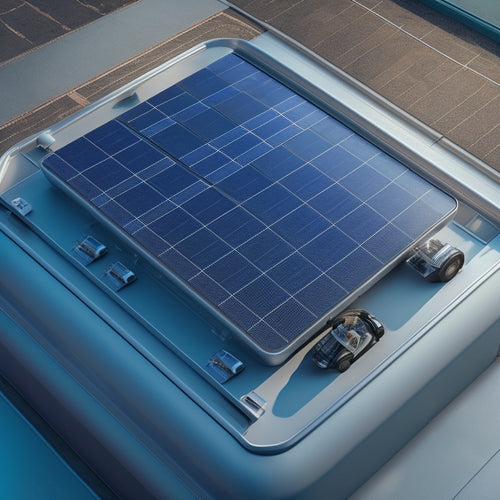
How to Achieve a Successful Solar Panel Installation in California
Share
To achieve a successful solar panel installation in California, you'll want to understand the state's solar laws, including net metering and the California Solar Initiative, which can help reduce upfront costs. Next, choose an experienced and reputable installer who can guide you in selecting the best solar panels for your needs, preparing your roof for installation, and managing permits and inspections. Finally, maximize energy efficiency by optimizing panel orientation and monitoring energy output. By following these steps, you'll be well on your way to a successful solar panel installation - and there's more to investigate to guarantee you get the most out of your investment.
Key Takeaways
- Understand California's solar laws, including Net Metering and the California Solar Initiative, to maximize benefits and incentives.
- Choose a reputable solar installer with local experience, a strong reputation, and comprehensive warranty options.
- Select high-efficiency solar panels suitable for California's climate, considering factors like durability, warranty, and temperature coefficient.
- Ensure your home's roof is prepared for installation by assessing its condition, age, and wear, and addressing any structural integrity concerns.
- Navigate permits and inspections efficiently by planning ahead, verifying compliance with local codes, and scheduling timely inspections.
Understanding California's Solar Laws
Since California is a pioneer in renewable energy, it's essential to understand the state's solar laws before installing solar panels.
You'll want to take advantage of the net metering benefits, which allow you to generate your own electricity and export any excess to the grid. This way, you can offset your energy consumption and reduce your utility bills.
California's solar laws also offer various solar incentives, such as the California Solar Initiative (CSI), which provides rebates for residential and commercial solar installations.
As a homeowner, you're eligible for the CSI program, which can help you reduce the upfront cost of your solar panel installation.
Additionally, you can benefit from the federal solar investment tax credit (ITC), which allows you to claim a tax credit of 26% of your total installation cost.
By understanding these solar laws and incentives, you can make an informed decision about your solar panel installation and maximize your savings.
Choosing the Right Solar Installer
Now that you're familiar with California's solar laws and incentives, it's time to focus on finding a qualified solar installer to bring your renewable energy vision to life. This is a vital step, as a reputable installer can make all the difference in the success of your solar panel installation.
When researching potential installers, look for those with extensive experience in solar panel installations, particularly in your local area. Check their customer reviews and ratings to get a sense of their reputation and quality of work.
Some key factors to take into account when choosing an installer include:
- Warranty options and their duration
- Installation timeline and project management process
- Financing options and potential partnerships with lenders
- Referral programs and incentives for customer referrals
Selecting the Best Solar Panels
As you prepare to harness the power of the California sun, selecting the best solar panels for your installation is essential to maximizing energy output and minimizing costs.
You'll want to take into account the different solar panel types, each with its own strengths and weaknesses. Monocrystalline silicon panels offer high efficiency ratings, but come at a higher cost. Polycrystalline silicon panels, on the other hand, provide a more affordable option with slightly lower efficiency. Thin-film panels are another option, offering flexibility and a lower price point, but with lower efficiency ratings.
When evaluating solar panels, look for efficiency ratings, measured in percentage, which indicate the panel's ability to convert sunlight into electricity. Higher efficiency ratings typically translate to more power per hour of sunlight.
You should also take into account the panel's durability, warranty, and temperature coefficient, which affects energy output in hot climates like California. By understanding these factors, you can make an informed decision and choose the best solar panels for your installation, ensuring you get the most out of your solar investment.
Preparing Your Home's Roof
With your solar panel selection in hand, it's time to shift focus to the surface that will support your new energy-harvesting system: your home's roof.
As you prepare for installation, it's important to assess your roof's condition to guarantee it can support the added weight and withstand the elements. A thorough inspection will identify any necessary repairs or replacements, preventing potential issues down the line.
When evaluating your roof, consider the following factors:
-
Roof age and condition: Is your roof nearing the end of its lifespan or showing signs of wear and tear?
-
Shading analysis: Are there any obstructions, such as trees or neighboring buildings, that could impact energy production?
-
Structural integrity: Can your roof support the weight of the solar panels and withstand wind, rain, and other environmental factors?
- Local building codes and regulations: Are there any specific requirements or restrictions governing roof-mounted solar installations in your area?
Navigating Permits and Inspections
You'll need to maneuver through the permit application process, which involves submitting plans and specifications to your local government for approval.
This guarantees your solar panel installation complies with California's building codes and safety standards.
Permit Application Process
The permit application process is an essential step in your California solar panel installation project, requiring careful attention to detail to maneuver through the complex web of permits and inspections.
You'll need to traverse various permit types, including electrical, building, and zoning permits, each with its own application timeline and requirements.
To guarantee a smooth application process, keep the following in mind:
-
Plan ahead: Allow at least 2-3 weeks for the permit application process to avoid delays in your installation project.
-
Gather required documents: Make certain you have all necessary documents, including your installation plan, electrical diagrams, and structural engineering reports.
-
Submit complete applications: Ascertain your applications are complete and accurate to avoid rejections and re-submissions.
- Follow up with the authorities: Regularly check the status of your permit applications to avoid unnecessary delays.
Compliance With Local Codes
Frequently, solar panel installation projects in California encounter setbacks due to non-compliance with local codes, resulting in costly reworks and delays.
To avoid this, you'll need to verify your project meets the requirements of your local jurisdiction. This includes adhering to solar zoning regulations, which dictate where solar panels can be installed on your property.
You'll also need to evaluate installation setbacks, such as maintaining a certain distance from property lines or other structures. Local incentives, like tax credits or rebates, may be available, but you'll need to comply with utility regulations to take advantage of them.
Additionally, you'll need to confirm your system meets energy storage and grid connection requirements. If you live in a development with a homeowner association, you may need to obtain their approval as well.
Inspection Scheduling and Results
Once you've confirmed your solar panel installation project complies with local codes, it's time to schedule inspections to validate your work.
You'll need to identify the required inspection types, which may include electrical, building, and fire safety inspections. Be sure to check with your local authorities to determine the specific inspections needed for your project.
To guarantee a smooth inspection process, create an inspection checklist that covers all aspects of your installation.
This should include:
- Electrical connections and wiring
- Panel mounting and securement
- Inverter installation and configuration
- Grounding and bonding systems
Maximizing Energy Efficiency
You'll want to optimize your solar panel orientation to guarantee maximum energy harvesting, as even slight deviations from the ideal angle can greatly impact energy production.
By monitoring your energy output in real-time, you'll be able to identify potential issues and make adjustments to optimize performance.
This proactive approach will help you squeeze every last kilowatt-hour from your solar panel system.
Optimize Panel Orientation
When it comes to utilizing the full potential of your solar panel system, optimizing panel orientation is vital. You want to confirm that your panels are positioned to capture the most sunlight possible, considering the solar angle and your location in California.
To optimize your panel orientation, consider the following factors:
-
Assess your roof's orientation: Identify the direction your roof faces and adjust your panel placement accordingly. South-facing roofs are ideal, but east- and west-facing roofs can also work well.
-
Conduct a shading analysis: Identify any obstacles that may cast shade on your panels, such as trees or neighboring buildings, and position your panels to minimize their impact.
-
Adjust for seasonal changes: California's sunny weather means you'll want to adjust your panel angle to take into consideration the changing seasons. A steeper angle in winter and a shallower angle in summer will help maximize energy production.
- Consult local regulations: Familiarize yourself with local building codes and regulations to confirm your panel installation meets all necessary requirements.
Monitor Energy Output
How much electricity are your solar panels really producing? To maximize energy efficiency, it's essential to monitor your energy output. This involves tracking your system's performance to guarantee it's generating the expected amount of electricity.
By doing so, you'll be able to identify any potential issues and make adjustments to optimize your energy production.
To effectively monitor your energy output, you'll need to employ advanced monitoring techniques. This typically involves installing a monitoring system that tracks your energy production in real-time.
This system will provide you with detailed data on your energy output, including the amount of electricity generated, the time of day it was produced, and any errors or issues that may be affecting performance.
Frequently Asked Questions
Can I Install Solar Panels on a Rented Property in California?
You'll need to review your lease agreements and understand your tenant rights before installing solar panels on a rented property in California, ensuring you have the necessary permissions and compliance with state regulations.
Are There Any Tax Incentives for Solar Panels in California?
You'll be glad to know that, yes, there are tax incentives for solar panels in California! You're eligible for federal incentives, like the Solar Investment Tax Credit, and state-specific solar rebates, which can substantially reduce your installation costs.
Will Solar Panels Increase My Property Value in California?
It's no coincidence that you're wondering about solar panels and property worth! As you invest in this eco-friendly upgrade, you'll reap the solar panel benefits, and studies show that property appreciation increases by up to 4.1% in California, making your home more desirable and worthwhile.
Can I Sell Excess Energy Generated Back to the Grid?
You can sell excess energy back to the grid through California's net metering benefits, which track your excess production and allow you to offset your energy bills, and investigate energy buyback options with your utility company.
How Long Does a Typical Solar Panel Installation Take in California?
You'll typically spend 2-3 months preparing for your solar panel installation, including project preparation and permitting, before the actual 1-3 day installation timeline, ensuring a seamless and efficient process from start to finish.
Conclusion
By following these steps, you've set yourself up for a successful solar panel installation in California. With the state's abundant sunshine, it's no wonder that California leads the nation in solar energy production - in fact, did you know that if California were a country, it would rank 5th in the world in solar energy production? Now, it's time to reap the benefits of your new solar panel system and start saving on your energy bills!
Related Posts
-

Top Solar Panels for Car Battery Maintenance
When selecting top solar panels for car battery maintenance, consider high-efficiency models with high wattage output...
-

Top Online Stores for Solar Car Accessories
When searching online for solar car accessories, you'll find top retailers like Amazon, REI Co-op, and Best Buy offer...
-

Best Solar Panel Options for Maximum Energy Savings
You can maximize your energy savings with solar panels that boast efficiency ratings above 20%, paired with extensive...


